3 Finales que todo ajedrecista debe conocer - 3 Endgames that every chess player should know
Hola Comunidad ajedrecista de hive, tiempo sin postear, el día de hoy les vengo a realizar un pequeño post para el crecimiento personal, y por su puesto aprender cada día más de nuestro juego, enfocándome en un tema muy importante de la fase de la partida. EL FINAL
Como ajedrecista he tenido una basta experiencia con una larga trayectoria, pero cometí muchos errores al momento de entrenar, muchos maestros recomiendan aprender finales, en esa fase de la partida es donde se nos escapan los puntos, partidas que hemos tenido ganada o con clara ventaja desde la apertura – medio juego, no la terminamos de rematar y dejamos escapar la tan anhelada victoria, o por el contrario aprender finales en el caso que estemos en desventaja material pero con teoría sólida podemos sacar unas tablas.
👉👉El primer final del que les hablare será del final Rey y Torre vs Rey y alfil.
Si, te has preguntado, ¿Cuantas veces has llegado a un final con una posición similar? Seguramente tu respuesta, es muchas veces, no tienes idea y por desconocimiento de la posición no has obtenido un buen resultado.
Observa el Diagrama
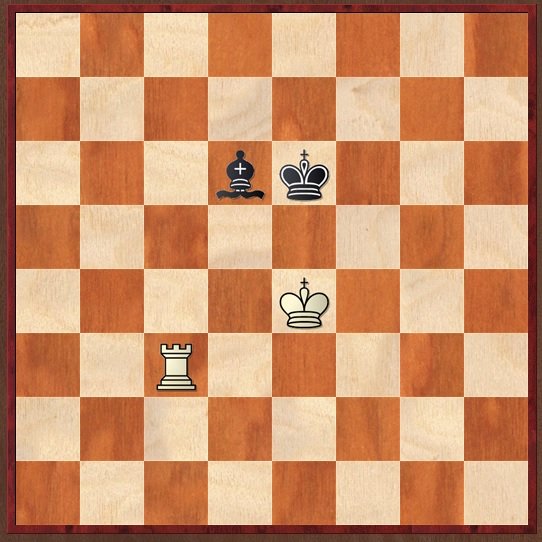
Esta es una posición tipica, puede jugar cualquier bando, pero ¿cual es la particularidad de este final?
♟El jugador que tiene la torre, en este caso las blancas deben buscar la victoria.
♟El jugador de piezas negras, lo más que puede obtener son tablas, y ahí es donde me enfocare, en explicarles como conseguir medio punto.

Entonces ya teniendo claro, que quiere cada bando vamos a enfocarnos en el bando de las negras, como conseguir las tablas.
Cuando estamos en una posición como esa, existen 4 esquinas del tablero, donde 2 esquinas son el lado bueno✅ y 2 esquinas el lado malo❌, lo explico de la siguiente manera.
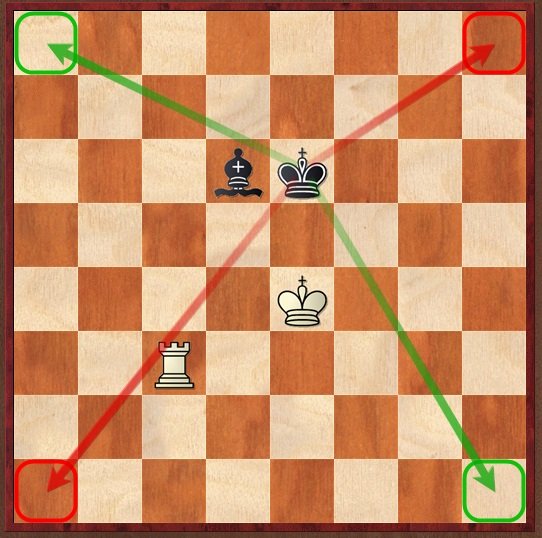
Las casillas en color verde, son las casillas que serían las ideales para colocar el Rey negro, y las casillas con el color rojo, son las casillas en las cuales el blanco obtendría fácilmente la victoria. Entonces dada una posición "x". El plan a seguir es llevar nuestro Rey a la casilla de color opuesto a nuestro alfil para que este pueda defendernos del jaque mate ++.

Como puedes observar, el alfil cubre el jaque mate ++. Ahora el bando blanco, si mantiene su torre en la última fila, o mueve su Rey a la casilla a6, quedaría ahogado. El plan del negro es mantener su Rey en esa casilla y dar jaque con el alfil y mantenerlo en la diagonal, para poder mantener las opciones de tablas. De esta manera es un final meramente teórico, no existe manera alguna por la cual el blanco gane en esta posición.


Aquí puedes observar, que el rey al estar del mismo lado de la casilla de su alfil, no tiene maneras de cubrirse del jaque mate ++.
Con estos diagramas te explico de manera ilustrativa cual es la casilla buena y mala para colocar al rey y defenderse, y en el caso del jugador que tenga torre debe saber que si el contrario se posiciona en una casilla buena, no podra obtener la victoria. ¿Espero haberte ilustrado, te has sentido identificado con este final? Te leo en los comentarios tus impresiones acerca del final.

El segundo final del que les hablare, se da mucho, es muy común en todas las categorías, y es común equivocarse en estas posiciones, yo lo título como el peón que detiene a 2 peones.

En la siguiente posición, la partida esta igualada materialmente, pero le toca jugar al bando blanco. La posición te da por si sola la respuesta pero hay que tener en cuenta en este tipo de posiciones varios elementos, (Oposición, Regla del Cuadrado, Triangulación) Son elementos importantes de los finales de reyes y peones.

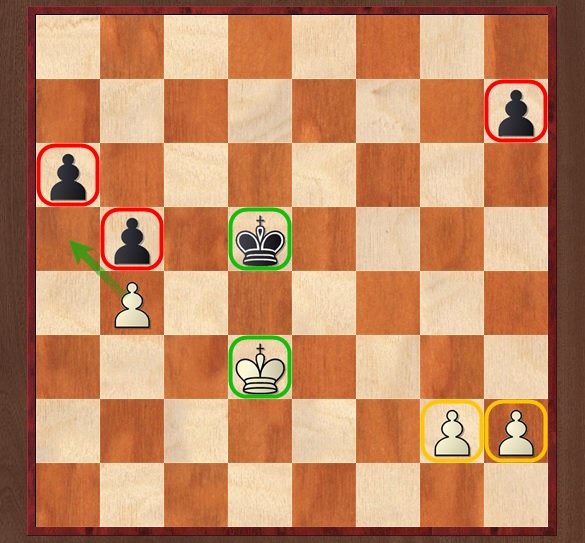
La jugada ganadora es 1.b4! Con esa jugada se detienen los dos peones del flanco de dama del negro. El final hay que jugarlo con cautela, precisión y con buena convicción para conseguir el triunfo.
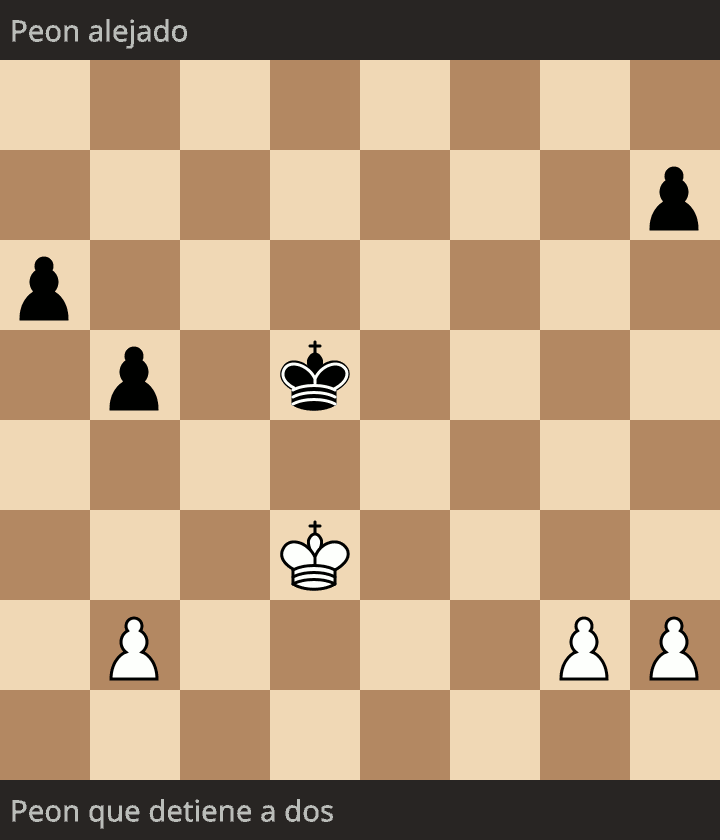

Por último y no menos importante, un tema que debemos tener en cuenta cada vez que estamos en un final de Reyes y peones, es LA RUPTURA DE PEONES. Con este ejemplo ilustrativo que les mostrare, pretendo que tengan presente en todo momento que los peones son un arma mortal para un rey alejado.
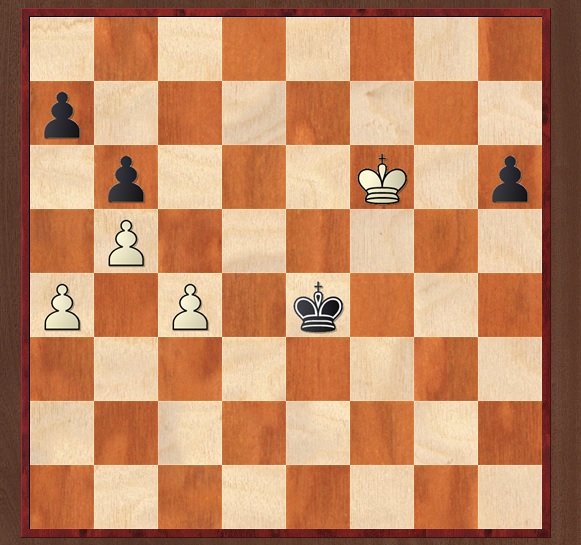
¿Al observar el diagrama y el título que se te viene a la mente 🧠?
Analicemos la posición, Juegan las blancas. 👀Observemos que estamos en igualdad material🤺, pero con una jugada simple y brillante se gana, este tema esta presente en muchos finales y es bueno rememorarlo.
1.c5 !! Con esta jugada comienza el desafío, ruptura de peones, regla del cuadrado presente.
1...bxc5 2.a5! Rd5 3.a6!
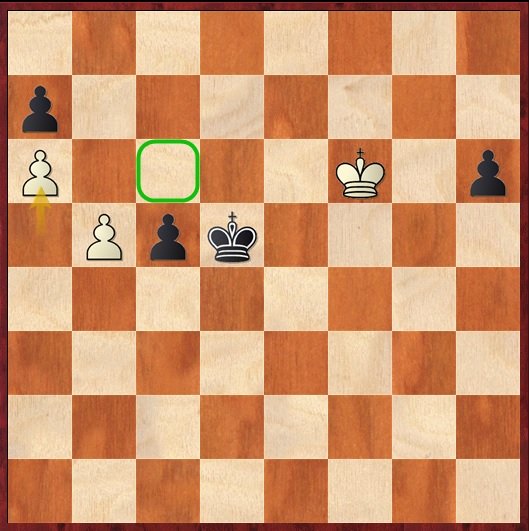
Jugada muy importante que impide acercarse al rey negro ya que la casilla c6 es inaccesible. La posición continuaría 3...c4 4.b6 con ventaja decisiva y victoria para las blancas.
Con esto finalizo mi post sobre 3 finales, posiciones que siempre pueden presentarse y derivan de cualquier apertura - defensa. El final se gana de una manera muy bonita y brillante.
Espero que esta información les resulte útil y se sumergan en el gran estudio del final. Un abrazo!

Fuentes:
♟Las imagenes son realizadas en el programa ChesBase, editadas en Paint.
♟La imagen gif del final es gracias a lichess.org.
♟Los separadores son de mi autoría

Hello hive chess community, long time no post, today I come to make a small post for personal growth, and of course learn more every day of our game, focusing on a very important issue of the phase of the game. THE END
As a chess player I have had a vast experience with a long trajectory, but I made many mistakes when training, many masters recommend learning endgames, in that phase of the game is where the points escape us, games that we have won or with a clear advantage from the opening - half game, we do not finish it off and we let escape the longed victory, or on the contrary learn endgames in the case that we are at a material disadvantage but with solid theory we can get a draw.
👉👉The first endgame I will tell you about is the King and Rook vs King and Bishop endgame.
Yes, you have asked yourself, how many times have you reached an endgame with a similar position? Surely your answer is many times, you have no idea and because of ignorance of the position you have not obtained a good result.
Look at the Diagram

This is a typical position, either side can play, but what is the particularity of this ending?
♟The player who has the rook, in this case white must seek victory.
♟The player with black pieces, the most he can get is a draw, and that is where I will focus, in explaining to you how to get a half point.

So already having clear, what each side wants let's focus on the black side, how to get the boards.
When we are in a position like that, there are 4 corners of the board, where 2 corners are the good side✅ and 2 corners the bad side❌, I explain it as follows.

The squares in green color, are the squares that would be ideal to place the black King, and the squares with the red color, are the squares in which white would easily obtain the victory. So given a position "x". The plan to follow is to take our King to the square of the opposite color to our bishop so that it can defend us from checkmate ++.

As you can see, the bishop covers checkmate ++. Now the white side, if it keeps its rook on the last rank, or moves its King to the square a6, would be stalemated. Black's plan is to keep his King on that square and give check with the bishop and keep it on the diagonal, in order to maintain the draw options. Thus it is a purely theoretical endgame, there is no way for white to win in this position.


Here you can see that the king, being on the same side of the square of his bishop, has no way to cover himself from checkmate ++.
With these diagrams I explain in an illustrative way which is the good and bad square to place the king and defend, and in the case of the player who has rook should know that if the opponent is positioned on a good square, he can not get the victory. I hope I have illustrated, have you felt identified with this ending? I will read in the comments your impressions about the ending.

The second endgame I will talk about is very common in all categories, and it is common to make mistakes in these positions, I call it the pawn that stops 2 pawns.

In the following position, the game is materially equal, but it is up to the white side to play. The position gives you by itself the answer but you have to take into account in this type of positions several elements, (Opposition, Square Rule, Triangulation). These are important elements of the endgame of kings and pawns.

The winning move is 1.b4! With that move the two pawns on black's queenside are stopped. The endgame must be played with caution, precision and with good conviction to win.


Last but not least, a subject that we must take into account every time we are in an endgame of Kings and pawns, is THE BREAKING OF PAWNS. With this illustrative example that I will show you, I intend to keep in mind at all times that pawns are a deadly weapon for a distant king.

Looking at the diagram and the title what comes to your mind 🧠?
Let's analyze the position, White plays. 👀We observe that we are in material equality🤺, but with a simple and brilliant move we win, this theme is present in many endgames and it is good to remember it.
1.c5 !! With this move begins the challenge, pawn break, square rule present.
1...bxc5 2.a5! Kd5 3.a6!

A very important move that prevents approaching the black king since the c6 square is inaccessible. The position would continue 3...c4 4.b6 with decisive advantage and victory for White.
With this I end my post on 3 endgames, positions that can always arise and derive from any opening - defense. The endgame is won in a very nice and brilliant way.
I hope you find this information useful and immerse yourself in the great study of the endgame. Best regards!

Sources:
♟The images are made in the ChesBase program, edited in Paint.
♟The gif image at the end is thanks to lichess.org.
♟The gif image at the end is thanks to lichess.org.
♟The separators are my authorship
♟Translate: https://www.deepl.com/es/translator

https://twitter.com/antonioalirio94/status/1508283591691755525
The rewards earned on this comment will go directly to the person sharing the post on Twitter as long as they are registered with @poshtoken. Sign up at https://hiveposh.com.
Congratulations @tony1294! You have completed the following achievement on the Hive blockchain and have been rewarded with new badge(s):
Your next target is to reach 4000 upvotes.
You can view your badges on your board and compare yourself to others in the Ranking
If you no longer want to receive notifications, reply to this comment with the word
STOPTo support your work, I also upvoted your post!
Check out the last post from @hivebuzz:
¡Enhorabuena!
✅ Has hecho un trabajo de calidad, por lo cual tu publicación ha sido valorada y ha recibido el apoyo de parte de CHESS BROTHERS ♔ 💪
♟ Te invitamos a usar nuestra etiqueta #chessbrothers y a que aprendas más sobre nosotros.
♟♟ También puedes contactarnos en nuestro servidor de Discord y promocionar allí tus publicaciones.
♟♟♟ Considera unirte a nuestro trail de curación para que trabajemos en equipo y recibas recompensas automáticamente.
♞♟ Echa un vistazo a nuestra cuenta @chessbrotherspro para que te informes sobre el proceso de curación llevado a diario por nuestro equipo.
Cordialmente
El equipo de CHESS BROTHERS
Excelente trabajo, Tony. Me alegraría seguir viendo el desarrollo de esta serie de posts sobre finales. El que más me gustó fue el de la ruptura. Es ciertamente muy útil.
Excellent work, Tony. I'd be happy to continue to see how this series of posts on endgames develops. The one I liked the most was the one about the pawn breakthrough. It was useful indeed.
Muchas gracias @eniolw ; lo tendre presente para seguir compartiendo información sobre finales. Un aspecto clave en todo ajedrecista es saber rematar la fase mas decisiva de la partida.
Thank you very much @eniolw ; I will keep it in mind to continue sharing information about endings. A key aspect in every chess player is knowing how to finish off the most decisive phase of the game.